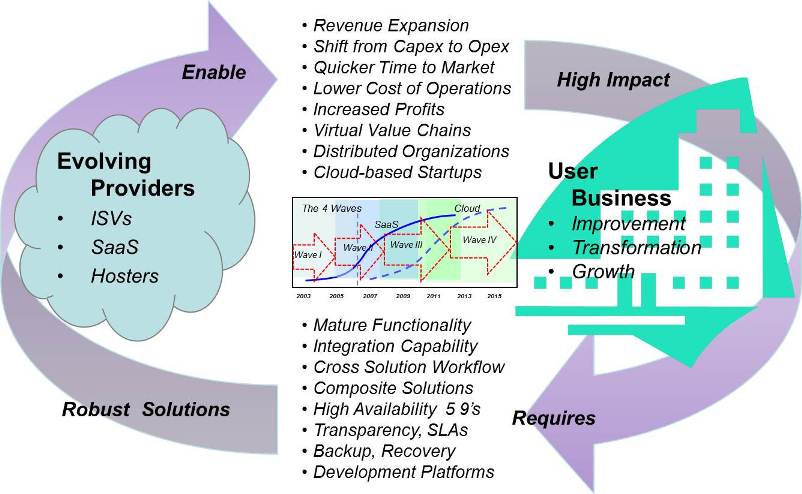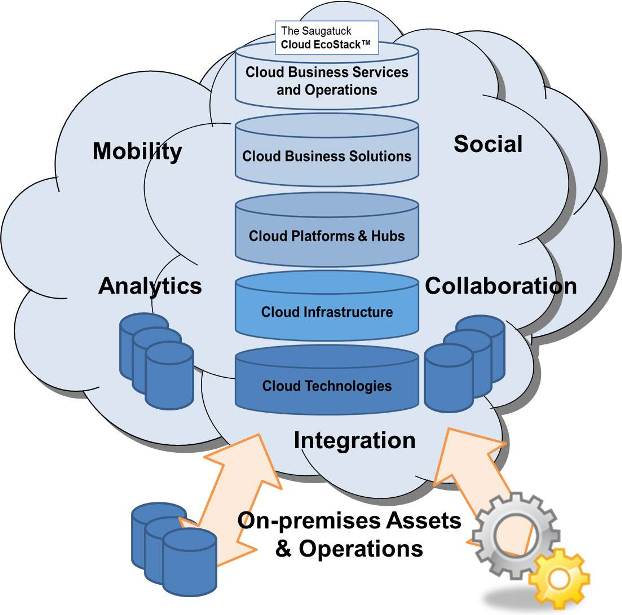Every 10 – 15 years, IT markets experience a fundamental shift in mission, architectures, roles and technology standards. In the desktop, client-server, and Web eras, we began referring to these as “paradigm shifts,” a term that has become almost as overused as “actionable” and “empowered.”
But every now and then, clichés hold true, and this is one of those times. IT and business camps alike are in the midst of a true paradigm shift, away from the traditionally static and boundary-defined enterprise business and IT fiefdoms, and toward what Saugatuck calls the “Boundary-free Enterprise™.” If we understand what enables the Boundary-free Enterprise, we can understand how the paradigm shift is occurring, and so figure out how to manage it as cost-effectively as possible.
Like most revolutions, this current paradigm shift has been going on for decades. It’s really only recently that the industry in general has been able to cobble together a unified view of what’s happening and what’s causing it.
Our core assumption is that there is such a thing as a “Boundary-free Enterprise.” While the terminology to describe and define it is still evolving, we can frame it as follows: Relatively few businesses of any size, in any industry, in any market today do not use IT to conduct at least some business in virtualized fashion. The physical business boundaries that led to vertically integrated enterprise organizational and IT architectures from the 18th century through today simply do not exist in the way that they have for centuries. We explore this in great detail in an ongoing research stream for our subscription research clients; for more information on that, please visit our website here.
As with so much else regarding IT and business, there isn’t much new in the way of concepts here. Various combinations of offshoring, outsourcing, and telework have reshaped the form of business and IT for decades.
What makes it different, challenging, and risky right now is that the “boundary-free” environment, engendered by cloud and its ubiquity of anything-as-a-service, has so quickly become the de facto, and expected, means of doing business and delivering and using IT, while we continue to stick with much older and traditional methods of managing both.
There’s nothing wrong with sticking with what works, of course, and much of our established IT and business management has been refined through decades of trial and error. What enterprises have is in place because it works better than most alternatives.
But within a few years, enterprises have found that what we have for IT and business management is increasingly inadequate, especially because our core structures lack the flexibility and agility to keep pace with the speed of business and IT innovation. Saugatuck started using the term “cloud speed” a few years ago to help clients envision just how far and how fast change is affecting their business and technology decisions and management.
“Cloud speed” derives from the endless cycles of innovation and change that Saugatuck first identified as part of our ongoing cloud IT market research in 2006, beginning with our work on costs, opportunities, and business change enabled by SaaS. Figure 1 summarizes the vision as articulated for Saugatuck clients since 2008.
 Source: Saugatuck Technology Inc.
Source: Saugatuck Technology Inc.
In this model, user organizations adopt cloud-based IT solutions and utilize them to improve organizational productivity and efficiencies, leading to more innovative ways of doing business. As this happens, users’ expectations of IT providers (cloud-based and otherwise) change and grow to meet their own changing needs and operations.
To compete, IT providers then must adapt and innovate to meet users’ demands in a profitable manner. This requires and enables more new and innovative solutions, which in turn enable and drive more business innovation by users, and the cycle continues. The net effect of this cycle is the acceleration of development and delivery in all markets, not just those that are cloud-specific.
In essence, “cloud speed” describes the environment in which IT providers and buyers/users need to build, develop, and re-invent themselves just to keep pace with market growth and demand shifts. Unfortunately, our enterprise IT and business foundations are nowhere near flexible enough to allow us to do this adequately. This is where the Saugatuck new Master Architecture comes in.
Traditional architectures have been built around technologies and processes that are either static, or which enforce relatively slow rates of change, in order to reduce risk. Avoiding sudden change helps avoid sudden risk; to paraphrase an aviation mantra, IT and business architectures have evolved to manage and operate through a constant series of small corrections.
In an environment where so much has to change relatively quickly in order to remain relevant and effective, such traditional architectures and their resulting organizations and approaches just can’t compete – literally. Businesses are finding that entire markets are leaving them behind when they can’t anticipate or respond at cloud speed.
So, what do we do? What types of approach, what type of architecture can enable the manner of flexibility needed while retaining the ability to manage and control as much as is necessary?
Based on our work with several hundred user enterprises, IT vendors, ISVs, and cloud service providers, Saugatuck has developed what we call the new Master Architecture model. Like today’s IT and business environments, it is still emergent and is expected to evolve and be refined in the months and years to come. But it contains the foundational elements required to support business and IT flexibility, while managing IT and business risk, and enabling business reward. Figure 2 summarizes Saugatuck’s working model of the new Master Architecture.
 Source: Saugatuck Technology Inc.
Source: Saugatuck Technology Inc.
In our view, this new Master Architecture is not based on a single computing-platform paradigm as in the past. Rather, it is based on multiple technologies and platforms that build synergies among themselves through loosely coupled and opportunistic exchanges of value.
This is a very different approach to managing IT, or business. It requires flexibility of thought as well as flexibility of technology and discipline. New ways of thinking about assets, costs, risks and rewards have to be developed and applied while maintaining and enforcing consistency.
And unfortunately, there’s no out-of-the-box solution. As enterprises evolve their understanding of the capabilities of this emerging Master Architecture – combining cloud, mobile, social and data analytics plus Integration to on-premises data assets – each one must find its own way of creating an anytime / anyplace hybrid computing network that will realize its competitive aims. While the challenges of navigating this journey are significant, the benefits of the Boundary-free Enterprise are transformative.
This is one of the defining characteristics of cloud value – and the emerging Master Architecture – for the Boundary-free Enterprise. Business enterprises taking advantage of anytime/anyplace hybrid computing must understand the nature of their risks and of the potential rewards.
On the vendor/provider side, any expectations of creating – or participating in – a dominant cloud platform today, as the Microsoft operating environment was in the PC era, are completely unrealistic. Rather than force proprietary standardization, successful providers will design solutions to interoperate with as many other solutions as possible in order to enable the aggregate value from their combined utility. Lock-in will more and more have to come from delivering business advantage, rather than technological advantage.
As with any true paradigm shift, this new Master Architecture will continue to be a challenge to assemble and manage, and requires new ways of looking at, acquiring and managing business solutions. Vision and execution will not be sufficient. Rather, the leaders within the Boundary-free Enterprise must take a new view as to how to evaluate vendors, manage risks and realize the rewards from this loosely coupled anytime / anyplace hybrid computing network.
Among other things, this means better ways of identifying how, why and when the mission and roles of IT orgs will change; putting into place new and better means of assessing relative risk and reward of the new and different types of solutions and providers; and finally finding effective, repeatable and quantifiable ways of measuring the real business value of IT.
Frameworks, models and guidance in these areas from firms like Saugatuck will be important advantages for enterprise IT and business leaders as they work through the whys and wherefores, and effects and costs, of this new paradigm.
But as the old joke goes, how many psychiatrists does it take to change a light bulb? The answer: Only one – but the light bulb has to really want to change. In this case, the enterprise, meaning the leaders of the enterprise in combined IT and business camps, will have to really want to change how they structure, organize and manage.
Bruce Guptill is SVP and head of research for Saugatuck Technology, a leading a provider of subscription research and advisory services focused on the key trends and disruptive technologies driving change in business computing. The emergence of the new Master Architecture enabling the Boundary-free Enterprise™ will be key themes at Saugatuck’s second annual Cloud Business Summit, to be held on November 14, 2012, at the Westin Times Square in New York City.
